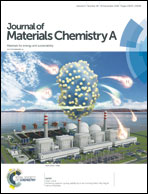Pt3 clusters-decorated Co@Pd and Ni@Pd model core–shell catalyst design for the oxygen reduction reaction: a DFT study†
Abstract
The high cost of oxygen reduction reaction (ORR) catalysts is a critical hurdle to fuel cell commercialization. In an effort to develop low-cost ORR catalysts with low noble-metal loading but high activity and stability, we designed model catalysts of small Pt3 clusters-decorated core–shell structures (e.g. Co or Ni as the core, Pd as the shell) by tuning the shell thickness, calculated by density functional theory (DFT). We found that incorporation of Pt3 into the bimetallic surface is more stable than adsorption of Pt3 on the surface. Additionally, the magnitude of atomic oxygen adsorption of our model catalysts depends on their adsorption sites and Pd thickness. Small Pt3-decorated Co@Pd and Ni@Pd model core–shell catalysts with exact monolayers of Pd are expected to exhibit high ORR activity based on their moderate atomic oxygen adsorption energies on various stable active sites, −0.57 to −0.93 and −0.53 to −0.96 eV, and moderate O2 dissociation reaction barriers, 0.74 to 0.87 and 0.59 to 0.72 eV. The d-band centers (εd) of selected model catalysts were computed; the outcomes reveal that the εd values of the optimum model catalysts are close to that of pure Pt(111) and fall around the top of the volcano plot, further demonstrating that high ORR activity should be expected.



 Please wait while we load your content...
Please wait while we load your content...